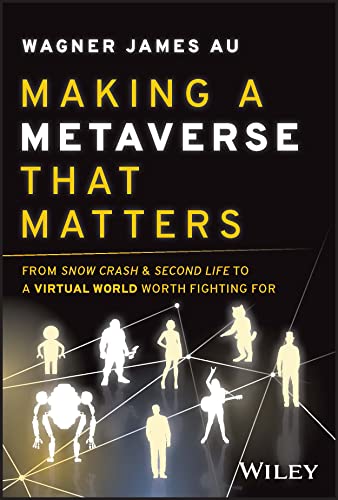Making a Metaverse That Matters: From Snow Crash and Second Life to A Virtual World Worth Fighting For
By Wagner James Au
Publisher: Wiley
ISBN: 978-1-394-15581-1
A couple of years ago, when “the metaverse” was the hype-of-the-month, I kept wondering why people didn’t just join 20-year-old Second Life, or a game world. Even then the idea wasn’t new: the first graphical virtual world, Habitat, launched in 1988. And even *that* was preceded by text-based MUDs that despite their limitations afforded their users the chance to explore a virtual world and experiment with personal identity.
I never really took to Second Life. The initial steps – download the software, install it, choose a user name and password, and then an avatar – aren’t difficult. The trouble begins after that: what do I do now? Fly to an island, and then…what?
I *did*, once, have a commission to interview a technology company executive, who dressed his avatar in a suit and tie to give a lecture in a virtual auditorium and then joined me in the now-empty auditorium to talk, now changedinto jeans, T-shirt, and baseball cap.
In his new book, Making a Metaverse That Matters, the freelance journalist Wagner James Au argues that this sort of image consciousness derives from allowing humanoid avatars; they lead us to bring the constraints of our human societies into the virtual world, where instead we could free our selves. Humanoid form leads people to observe the personal space common in their culture, apply existing prejudices, and so on. Au favors blocking markers such as gender and skin color that are the subject of prejudice offline. I’m not convinced this will make much difference; even on text-based systems with numbers instead of names disguising your real-life physical characteristics takes work.
Au spent Second Life’s heyday as its embedded reporter; his news and cultural reports eventually became his 1999 book, The Making of Second Life: Notes from a New World. Part of his new book reassesses that work and reports regrets. He wishes he had been a stronger critic back then instead of being swayed by his own love for the service. Second Life’s biggest mistake, he thinks, was persistently refusing to call itself a game or add game features. The result was a dedicated user base that stubbornly failed to grow beyond about 600,000 as most people joined and reacted the way I did: what now? But some of those 600,000 benefited handsomely, as Au documents: some remade their lives, and a few continue to operate million-dollar businesses built inside the service.
Au returns repeatedly to Snow Crash author Neal Stephenson‘s original conception of the metaverse, a single pervasive platform. The metaverse of Au’s dreams has community as its core value, is accessible to all, is a game (because non-game virtual worlds have generally failed), and collaborative for creators. In other words, pretty much the opposite of anything Meta is likely to build.

One thought on “Review: Making a Metaverse That Matters”